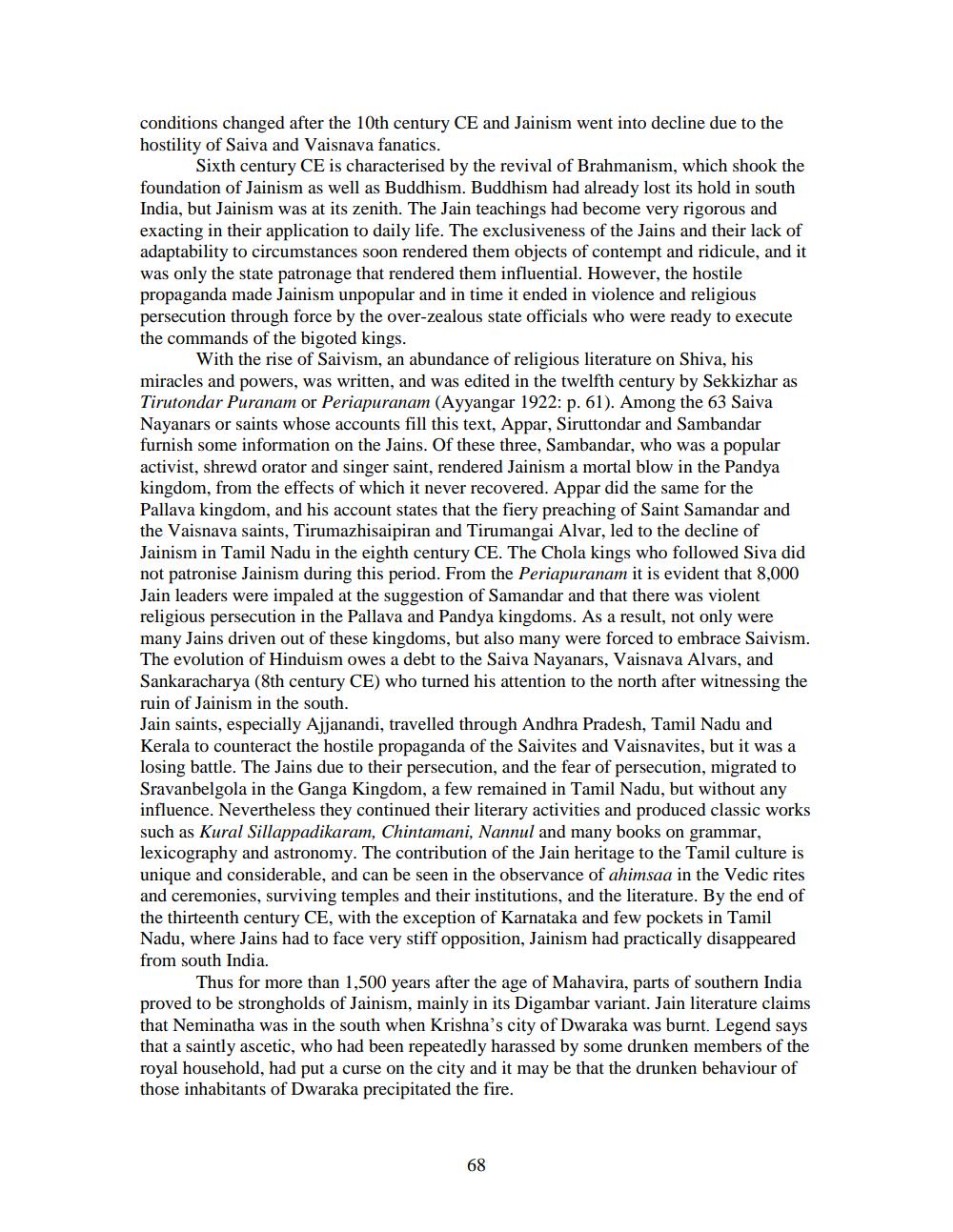________________
conditions changed after the 10th century CE and Jainism went into decline due to the hostility of Saiva and Vaisnava fanatics.
Sixth century CE is characterised by the revival of Brahmanism, which shook the foundation of Jainism as well as Buddhism. Buddhism had already lost its hold in south India, but Jainism was at its zenith. The Jain teachings had become very rigorous and exacting in their application to daily life. The exclusiveness of the Jains and their lack of adaptability to circumstances soon rendered them objects of contempt and ridicule, and it was only the state patronage that rendered them influential. However, the hostile propaganda made Jainism unpopular and in time it ended in violence and religious persecution through force by the over-zealous state officials who were ready to execute the commands of the bigoted kings.
With the rise of Saivism, an abundance of religious literature on Shiva, his miracles and powers, was written, and was edited in the twelfth century by Sekkizhar as Tirutondar Puranam or Periapuranam (Ayyangar 1922: p. 61). Among the 63 Saiva Nayanars or saints whose accounts fill this text. Appar, Siruttondar and Sambandar furnish some information on the Jains. Of these three, Sambandar, who was a popular activist, shrewd orator and singer saint, rendered Jainism a mortal blow in the Pandya kingdom, from the effects of which it never recovered. Appar did the same for the Pallava kingdom, and his account states that the fiery preaching of Saint Samandar and the Vaisnava saints, Tirumazhisaipiran and Tirumangai Alvar, led to the decline of Jainism in Tamil Nadu in the eighth century CE. The Chola kings who followed Siva did not patronise Jainism during this period. From the Periapuranam it is evident that 8,000 Jain leaders were impaled at the suggestion of Samandar and that there was violent religious persecution in the Pallava and Pandya kingdoms. As a result, not only were many Jains driven out of these kingdoms, but also many were forced to embrace Saivism. The evolution of Hinduism owes a debt to the Saiva Nayanars, Vaisnava Alvars, and Sankaracharya (8th century CE) who turned his attention to the north after witnessing the ruin of Jainism in the south. Jain saints, especially Ajjanandi, travelled through Andhra Pradesh, Tamil Nadu and Kerala to counteract the hostile propaganda of the Saivites and Vaisnavites, but it was a losing battle. The Jains due to their persecution, and the fear of persecution, migrated to Sravanbelgola in the Ganga Kingdom, a few remained in Tamil Nadu, but without any influence. Nevertheless they continued their literary activities and produced classic works such as Kural Sillappadikaram, Chintamani, Nannul and many books on grammar, lexicography and astronomy. The contribution of the Jain heritage to the Tamil culture is unique and considerable, and can be seen in the observance of ahimsaa in the Vedic rites and ceremonies, surviving temples and their institutions, and the literature. By the end of the thirteenth century CE, with the exception of Karnataka and few pockets in Tamil Nadu, where Jains had to face very stiff opposition, Jainism had practically disappeared from south India.
Thus for more than 1,500 years after the age of Mahavira, parts of southern India proved to be strongholds of Jainism, mainly in its Digambar variant. Jain literature claims that Neminatha was in the south when Krishna's city of Dwaraka was burnt. Legend says that a saintly ascetic, who had been repeatedly harassed by some drunken members of the royal household, had put a curse on the city and it may be that the drunken behaviour of those inhabitants of Dwaraka precipitated the fire.




